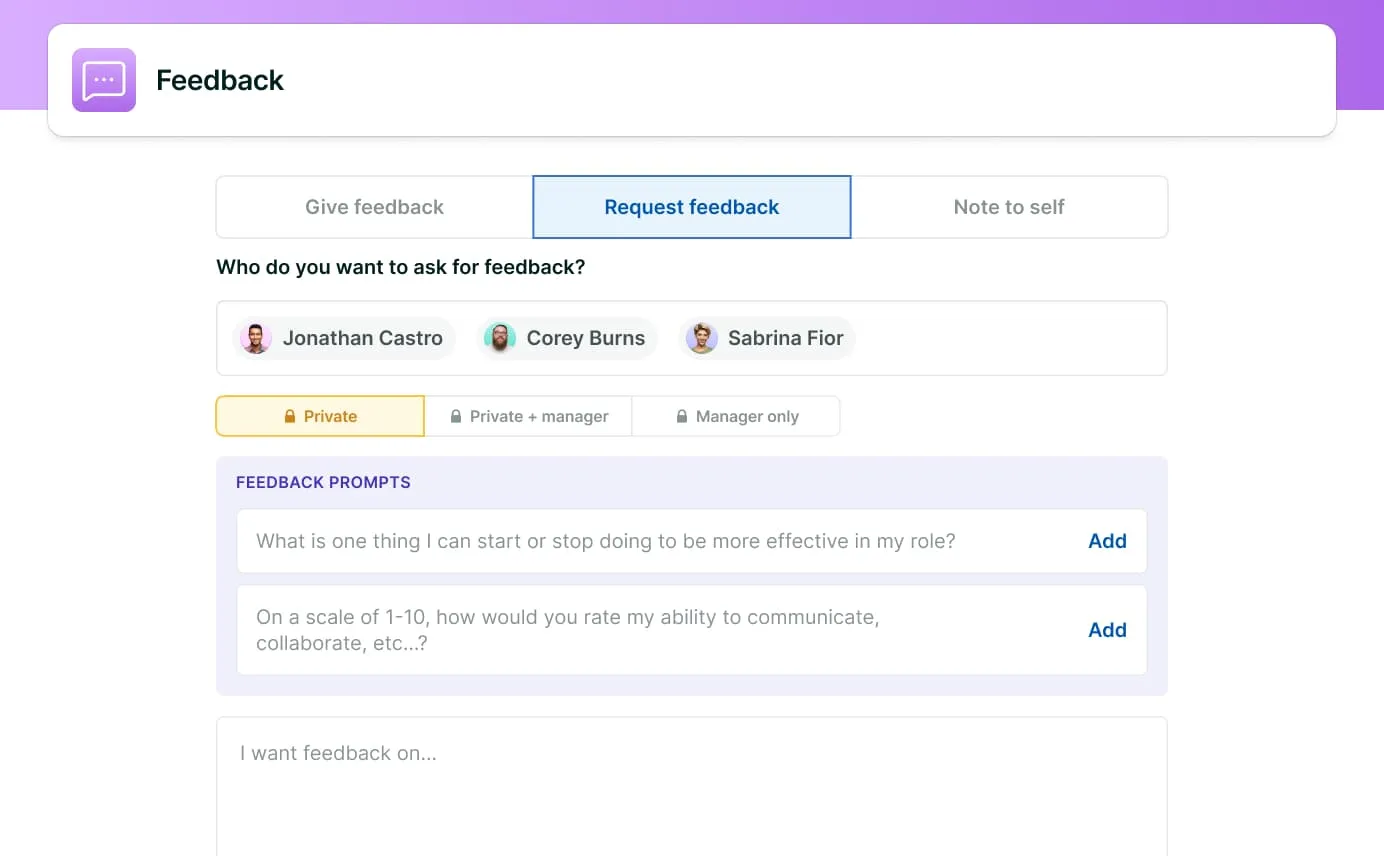Good managers know that honest conversations improve performance and results, but balancing hard truths with helpful guidance is a challenge.
“Feedback is one of the most underutilized levers for growth,” said Anu Mandapati, founder and chief culture, talent, and leadership strategist at Qultured, a consultancy that helps companies foster healthy, high-performing cultures. “When it’s done well, it builds trust, improves performance, and drives alignment between individuals’ actions and a team’s or organization’s business goals.”
Whether you’re an experienced manager or just stepping into a leadership role, this guide will help you transform employee feedback from an anxiety-inducing obligation into a natural part of your team’s success story.
Why Feedback Matters
“The intent of feedback is to influence further performance,” said Denitresse Ferrell, founder and CEO of leadership and professional development consultancy Culture Refinery, in our article on employee feedback best practices. “That’s the whole end goal.”
When employers avoid giving feedback, they create a vacuum where confusion, resentment, and missed opportunities flourish. This can result in surprising — and disappointing — performance reviews. But thoughtful, constructive feedback helps people understand both their strengths and growth areas, leading to better individual performance, robust employee engagement, and stronger teams. Using a continuous feedback approach is especially valuable for new hires who benefit from clear guidance early in their roles.
Mandapati shared this example: “I once worked with a tech company where the product and marketing teams were misaligned, leading to delays and rework. Through facilitated feedback sessions, each team finally heard how their actions impacted the other and what they needed to succeed. The result was a deeper understanding, faster turnaround, better communication, and best of all — all future product launches met deadlines.”
Good feedback isn’t about pointing out mistakes or just sticking with positive feedback. It’s about helping employee performance, supporting teamwork, developing better managers, improving retention, and ultimately driving continuous improvement.
Mindsets for Delivering Feedback Well
The right mindset shapes how employee feedback is both delivered and received. “Feedback is not a reflection of who someone is,” Mandapati said. “It’s a snapshot in time of how their behavior is being perceived. The sole purpose of feedback, positive or constructive, is to help them grow.”
To give feedback that produces good outcomes:
- Act with care and clarity, not conflict. When feedback comes from a place of genuine concern for a person’s growth, it changes the dynamic. It is support rather than criticism.
- Reflect curiosity, not certainty. Approach conversations with questions, not assumptions. This opens the door to dialogue, encouraging learning and problem-solving skills.
- Balance candor with compassion. Use frameworks like Radical Candor (care personally, challenge directly). Direct feedback delivered with care helps people improve without feeling demoralized.
- Remember to acknowledge wins. Recognizing excellent work is just as important as addressing areas for improvement.
Successful leaders know how to give effective feedback, and they're also able to receive it with grace. Managers “should model vulnerability and openness” by sharing “their own feedback journey” with their teams, said Jackie Lauer, workplace culture expert and executive coach. When leaders “demonstrate that they actively seek and act on feedback,” it affects how their team members respond. Leaders can gain insights from 360-degree feedback or manager feedback surveys, which help identify blind spots and allow input from direct reports and peers.
When working with the entire team, managers should be mindful that employee feedback preferences and reception can vary across cultures. Some employees may expect direct communication, while others respond better to more nuanced approaches. Good managers support employees’ wellbeing, taking the time to understand individual and cultural communication styles, without sacrificing clarity.
In addition to having the right mindset, other considerations can prevent a bad experience and a poor performance review.
Common Mistakes Managers Make When Giving Feedback
Even the best managers sometimes fall into these traps when trying to recognize good work or address performance issues:
- Being vague or overly indirect. Saying something like “you need to be more proactive” leaves people confused about what exactly needs to change.
- Giving feedback too late or in the wrong setting. Waiting days or weeks to address an issue dilutes the impact of your feedback and creates unnecessary anxiety. Choose appropriate, private settings for conversations.
- Making it personal instead of focusing on behavior or impact. Focus on observable actions and their effects rather than attributing motives or character flaws.
- Creating confusion with the “sandwich” method. While the feedback sandwich method (positive-negative-positive) is popular, it can sometimes dilute the message or confuse employees about the main point.
- Using feedback as a monologue rather than a conversation. One-way, negative feedback rarely leads to meaningful change. Create space for dialogue and mutual understanding.
Kimberly Prescott, founder and president of Prescott HR, recommends providing feedback within 24 hours of an event. “Everything is much more fresh in our mind about what happened in that situation,” she said in our article on employee feedback best practices. “If it’s related to your job, the likelihood that you’re going to have to do it again or that you’re still working on it is very high. I want that to be corrected as soon as possible.”
Managers should be “actively asking for feedback before providing it so it’s a dialogue, not a monologue,” Mandapati said.
{{rich-highlight-1}}
How to Structure Feedback
Having a go-to structure makes effective employee feedback clearer and more actionable. Methods to consider include:
- SBI (Situation, Behavior, Impact): The SBI Model, from the Center for Creative Leadership, calls for managers to name the specific situation, describe what was observed, and explain the impact it had. For example: “During yesterday’s client call, when you presented the timeline, the client seemed confused by the lack of detail, which led to follow-up questions we weren’t prepared for.”
- COIN (Connection, Observation, Impact, Next Steps): Though it’s somewhat similar to the SBI Model, the COIN model adds explicit next steps for improvement, leading to action and growth. For example: “Hi, Sara. Thanks for taking the time to talk with me today. I’d like to discuss yesterday’s team meeting (connection). During the meeting, I noticed you were multitasking and responding to emails (observation), which meant we missed your input on the product roadmap and had to revisit decisions later (impact). Going forward, could we agree that laptops stay closed during strategic discussions, or if you have an urgent matter, you let us know you need to step out briefly (next steps)?”
- Lattice’s built-in feedback templates: Lattice Feedback provides templates to guide managers and employees through structured, effective feedback conversations.
Sometimes, less is more when trying to start the conversation. Mandapati recommends a simple framework of observation, impact, and inquiry. She gave the following example: “I noticed the client didn’t get the report until the next day. That created a lot of stress on their end. What got in the way?” This approach is descriptive rather than judgmental and opens up dialogue.
Using AI To Give Better Feedback
AI tools can help polish your feedback approach. Here are some prompts for asking AI to evaluate your feedback, identify bias, suggest better vocabulary, and more:
- “Review this feedback for potential bias.”
- “Help me be more specific in this feedback.”
- “How could I reframe this more constructively?”
- “What would make this feedback more actionable?”
- “How can I highlight communication skills in this role?”
- “Explain why time management is critical for this task.”
- “Discuss how building new skills is part of professional development.”
- “What are some milestones for reaching goals?”
AI can catch things that are easily missed and find more effective wording, particularly for challenging conversations. With structures and tools in place, there are some best practices to help deliver feedback that resonates.
Feedback Dos and Don’ts
These simple guidelines can transform how your insights land, helping fuel employee growth and improvement.
Do:
- Give feedback close to the moment. Timely feedback ensures details are fresh and allows for quick course correction.
- Be specific. The feedback “Your report lacked detail” is less helpful than “The financial projections section would be stronger with three-year comparison data.”
- Invite dialogue. After sharing your observation, ask questions like “What’s your take on this?” or “What context am I missing here?”
- Ask AI for help. When you’re struggling with wording, AI tools can help you find a clearer, more constructive approach.
- Find the right frequency. Balance is key — too little feedback leaves people guessing, while too much can overwhelm. Regular feedback check-ins create an ongoing dialogue that’s more effective than relying solely on annual reviews.
What matters is connecting feedback to the hard work everyone’s putting in. “You always want to think about the impact,” Prescott said. “You want to make sure the focus is on the organization or the team or the department or the project because it takes the personal out of it.”
Don’t:
- Critique in public. Public negative feedback, especially constructive criticism, can trigger unnecessary embarrassment and defensiveness. Instead, share critical feedback in private, like your next one-on-one.
- Use assumptions. Stick to what you’ve observed rather than assuming you know why someone did something.
- Ignore power dynamics. Remember that your position affects how your words land. The same suggestion can feel harsher coming from a manager than from a peer.
While in some cases, real-time responses may be necessary, managers who are mindful of time and place get respect from team members. “Have these conversations in private, neutral settings where the person feels safe and comfortable,” Lauer said. Remember, a meeting with external stakeholders is not a good time to provide feedback.
Examples of Feedback for Different Scenarios
Below, you’ll find suggestions for adapting your approach based on context, the person, and desired outcomes.
Praise vs. Constructive Feedback
Just because feedback isn't praise doesn't mean it can't still be supportive. Consider these examples of praise and constructive feedback about how an employee handled a client meeting.
{{rich-highlight-2}}
Giving Feedback Remotely
Distance can complicate feedback conversations, making clarity and intentionality even more important to supporting company culture. When teams are remote:
- Be explicit about the purpose of the conversation.
- Use video when possible to catch non-verbal cues.
- Follow up in writing with key points.
- Be crystal clear about next steps.
Giving Feedback About the Same Issue Repeatedly
Recurring issues require a different approach that acknowledges the repetition while keeping a constructive tone. When addressing an ongoing problem:
- Name the pattern. “We’ve talked about missed deadlines several times now.”
- Get curious about root causes. “What’s getting in the way of meeting these deadlines?”
- Be clear about expectations. “Going forward, I need project phases completed by the agreed dates so we can meet deadline commitments.”
- Offer support. “Would additional resources, different check-in points, or new challenges help you to grow in this area?”
How Lattice Supports Better Feedback
Creating a feedback-rich company culture takes practice. “I have seen a whole culture change in the best way when we have intentionally introduced great feedback practices,” Lauer said.
Lattice understands that building a feedback process is easier with the right tools:
- Lattice Feedback: Use built-in templates to guide effective feedback conversations, recognize good work, and make continuous feedback a natural part of performance management.
- Lattice 1:1s: Facilitate follow-up on feedback, ensuring conversations lead to real growth.
- Lattice Grow: Connect feedback directly to employee goals, creating clear links between feedback and professional development.
- Lattice Engagement: Spot where unclear feedback might be affecting team trust or employee experience through targeted surveys.
{{rich-highlight-3}}

Feedback doesn't have to be scary.
Lattice’s free workbook How to Request, Give, and Receive Feedback provides practical templates, exercises, and guides to help you and your team master effective feedback conversations.
Praise example:
“That client presentation yesterday was really impressive. Your positive attitude and how you took complex data and made it digestible really stood out. I noticed how engaged they were during your timeline explanation.”
Constructive feedback example:
“I wanted to talk about yesterday’s client meeting. When questions came up about implementation timelines, I noticed some hesitation in your responses. The client picked up on this and emailed me with concerns afterward. What preparation might help you feel more confident in the next client conversation?”
Lattice Makes Feedback Your Superpower

When feedback becomes embedded in your team’s everyday conversations — delivered with care, received with openness, and focused on growth — it transforms from an occasional, dreaded event into a powerful driver of success that takes employee development to the next level. Managers who master the art of effective feedback demonstrate strong leadership skills. Employee engagement thrives, and everyone’s hard work pays off.
A key sign of success is when “Feedback becomes a regular, natural part of everyday interactions rather than a quarterly or annual event,” Lauer said, emphasizing that the goal is to normalize a continuous feedback loop.
Want to transform your organization’s work environment and build a strong feedback culture? Schedule a demo to see how Lattice can help your team create a culture of meaningful, continuous feedback.








